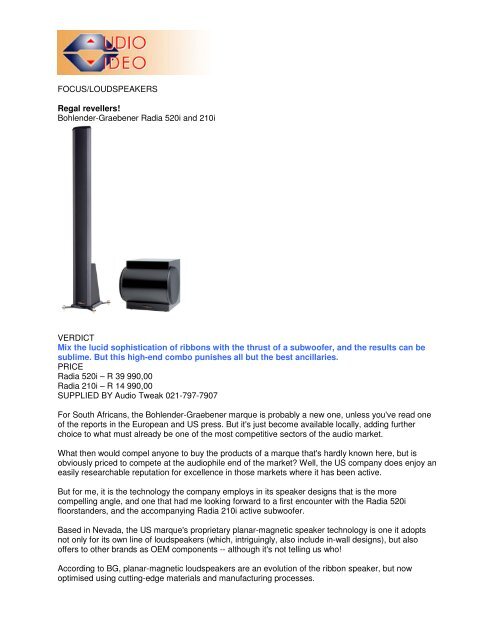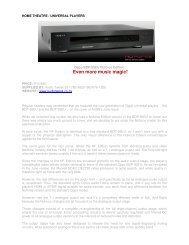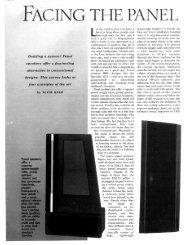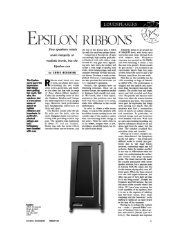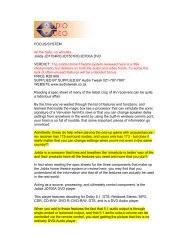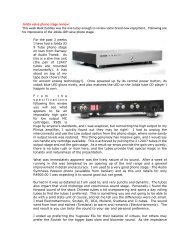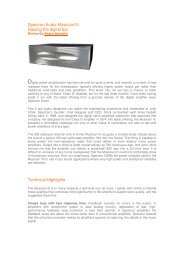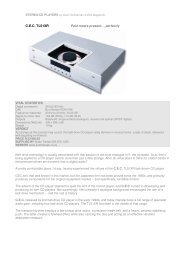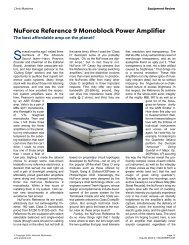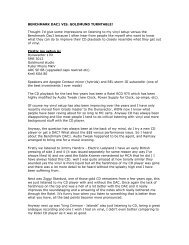review: AVSA magazine (Deon Schoeman) - Audio Tweak
review: AVSA magazine (Deon Schoeman) - Audio Tweak
review: AVSA magazine (Deon Schoeman) - Audio Tweak
You also want an ePaper? Increase the reach of your titles
YUMPU automatically turns print PDFs into web optimized ePapers that Google loves.
FOCUS/LOUDSPEAKERSRegal revellers!Bohlender-Graebener Radia 520i and 210iVERDICTMix the lucid sophistication of ribbons with the thrust of a subwoofer, and the results can besublime. But this high-end combo punishes all but the best ancillaries.PRICERadia 520i – R 39 990,00Radia 210i – R 14 990,00SUPPLIED BY <strong>Audio</strong> <strong>Tweak</strong> 021-797-7907For South Africans, the Bohlender-Graebener marque is probably a new one, unless you've read oneof the reports in the European and US press. But it's just become available locally, adding furtherchoice to what must already be one of the most competitive sectors of the audio market.What then would compel anyone to buy the products of a marque that's hardly known here, but isobviously priced to compete at the audiophile end of the market? Well, the US company does enjoy aneasily researchable reputation for excellence in those markets where it has been active.But for me, it is the technology the company employs in its speaker designs that is the morecompelling angle, and one that had me looking forward to a first encounter with the Radia 520ifloorstanders, and the accompanying Radia 210i active subwoofer.Based in Nevada, the US marque's proprietary planar-magnetic speaker technology is one it adoptsnot only for its own line of loudspeakers (which, intriguingly, also include in-wall designs), but alsooffers to other brands as OEM components -- although it's not telling us who!According to BG, planar-magnetic loudspeakers are an evolution of the ribbon speaker, but nowoptimised using cutting-edge materials and manufacturing processes.
BG's evolution of the ribbon speaker uses an electromagnetic force to manipulate aluminiumconductors contained in the surface of the speaker diaphragm, ensuring direct, uniform diaphragmmovement without unwanted resonance or anomalies in phase coherence. The ultra-low mass of theplanar-magnetic diaphragm also allows very accurate, and very fast, transient responses.The Radia 520i is a handsome beast, with a tall, column-shaped enclosure that actually consists oftwo parts -- a lower MDF section housing the two 133 mm mid/bass drivers, and an attachedaluminium tower with a 1 270 mm planar-magnetic ribbon driver.The entire assembly stands 1,78 m tall, but is only 197 mm wide, while the mid/bass enclosure, whichalso acts as the anchor for the system, extends 450 mm rearwards. Extensions housing screw-incoupling spikes are provided, and are vital to the performance of these speakers.BG claims an effective frequency range of 70 Hz to 20 kHz from this 4 ohm-rated design, with thepassive crossover point between the mid/bass units and the planar line source driver set to 350 Hz.The accompanying sensitivity of 88 dB/1 watt/1 m indicates reasonable efficiency: the recommendedamplification range is between 50 and 250 watts. However, to boost low-frequency response, asubwoofer is a must.For that reason, BG provides the Radia 210i active subwoofer. Stylish and compact, it matches theaesthetics of the Radia 510i, but still packs a powerful punch.Employing twin 200 mm Kevlar-coned drivers linked to a digital power amp rated at 500 watts, theRadia 210i's frequency range of 20 Hz to 150 Hz is variable, as are input level and phase. The driversare mechanically coupled and are mounted facing in opposite directions, while operating in phase tocancel reactive forces and boost dynamic response.Combined, the Radia 520i and 210i make for an impressive sight in any listening room, but due totheir small footprint, they don't take up much space, and will in fact happily operate in smaller areas,too.Let's get down to business: sonically, these BGs need time to settle in, and lots of experimentation tosite correctly. Gloss over these steps, and you're likely to remain unimpressed, at least initially. But thetime invested in running in and finding just the right positioning is repaid in full once everything is upand running properly.The first aspect that strikes you about these speakers is the staging and the transparency -- traditionalstrengths of planar designs that again come to the fore here. That despite the very narrow planardriver, which manages to create a huge horizontal soundstage.The sound field is actually cylindrical, which is less susceptible to floor and ceiling reflections thannormal driver arrays. Also, the planar driver's simple aluminium tower mount dramatically reduces anydanger of enclosure resonance.All this translates into a very open, detailed and expressive sound, spread out over a soundstage thatis holographic in proportion and accessibility, so that the music takes on a dimensional realism verydifficult to emulate with normal loudspeakers.It's this accessibility that's always endeared ribbon and planar speakers (think Magneplanar and QuadESL63) with real music lovers. But there's also dynamic response, speed and linear tonality toconsider here, and the Radia 520i shines in all these respects, too. It makes for exciting, even heartstoppinglistening.The bass response, on the other hand, needs help -- which it gets, in no uncertain terms from theRadia digital active subwoofer. Finding just the right crossover point in the listening room proved to bedifficult at first, but experimentation paid off eventually, and was vital to the overall performance.The 210i added the kick and impetus missing before, although it will sound either too emphasised, ortoo subtle, if the adjustment is not absolutely perfect.
With the extra bottom-end foundation, the music soared with even greater credibility and presence,making the music come alive with such intensity that the realism was almost scary.Be aware, however: ancillaries not up to the standards of these speakers will be severely andunceremoniously dealt with. The BGs are not friendly speakers, using their openness, transparencyand penchant for precision to spotlight and criticise digital glare, distortion or any other negative sonicartefacts.But in the right company, they deliver the music with stunning presence. Treble takes on an almostliquid intensity, the midrange is loaded with texture and emotion, and the bass is athletic and punchy.The BG Radia 520is and their 210i subwoofer partner are true high-enders that will surely find theirniche, despite the intense competition in the speaker market. Their unusually attractive design andsmall footprint will be further, practical recommendations. But beware: once you've heard them, you'llbe smitten!<strong>Deon</strong> <strong>Schoeman</strong>


